
Toy Shop was a tabloid sized periodical running action figure ads that I used to love reading during the late 1990s. I've been rereading old issues of it lately because I want to do a show about the more robotastical ads within its pages. Well in the July 4, 1997 issue of Toy Shop there was one such ad looking to sell "an original one-of-a-kind gauche painting by D. Schlenkofer [sic]". But this wasn't just any piece of Transformer art-it was THE piece. It was the original of the 1984 Transformers battle scene which appeared on the back of every boxed Transformer package in 1984 and on numerous other licensed Transformers products. Everything from lunch boxes to puzzles to pack-in catalogs, collector cases, sleeping bags, underwear, and much more had this epic scene printed on them. The ad text could have described the painting as the Mona Lisa of toy robots art and it wouldn't have been an understatement. There is no image more iconic in Transformers history than this painting, and for at least that one moment in 1997 the original was up for sale. Although the opportunity to buy it has long since passed, the ad gave me something else extremely valuable-the name of the artist who painted it.
It's been years since I last saw this ad and seeing it again now in this age of social networking made its rediscovery almost more exciting than seeing it for the first time back in'97. Armed with the artist's name, I took to doing some internet searching. After a bit of Googling I found two important pages. The first was the July 17, 2010 episode of the Protoculture Times podcast where Mr. Schleinkofer was interviewed by host John Thomas. It's the only interview I've been able to find of him. I highly recommend listening to that episode because it laid the foundation for the questions I would ask in my own interview. The second link was Mr. Schleinkofer's Flickr, which is a fantastic archive of much of his more famous works, including the '84 Transformers battle scene and the covers to the Jack McKinney Robotech novels. Looking through his Flickr I was blown away by how Mr. Schleinkofer's body of work encompassed many more memorable pieces than just that one Transformers painting. From magazine covers and article illustrations to advertising, book covers, video game packaging, fine art and beyond, he's done a ton of paintings that many people would recognize but that few would know were his.
Here then is the Q&A email correspondence we had. Of course my thanks go out to Mr. Schleinkofer, who took on the deluge of questions I had and was lightning fast with his in-depth responses. If you'd like to contact him he can be reached at Artist20 (at) verizon.net . You can also leave comments on his various artworks at his Flickr. Mr. Schleinkofer will also have works on exhibit at the 2013 Bucks County Illustrators Society 2013 Member Show from June 26 through June 28th, with a reception on June 26th from 2-4 pm.
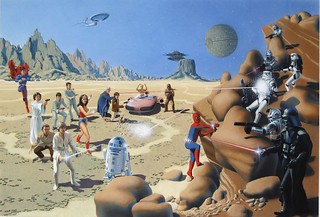 | 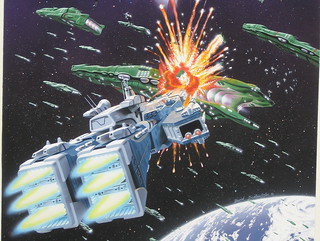 |
|---|
David Schleinkofer: I feel that I did inherit my talent from my Dad's father. I remember as a kid, 5-6-7 years old, going over to his row house in Philadelphia, PA., and seeing his art work which were fine art paintings hanging in the living room and thinking they were pretty cool. When I went into his upstairs work area he had all kinds of model airplanes and jets, some beautifully done wooden models and a few others in plastic. In his basement he had telescope lenses he made and used to look at the stars and planets and he had a lot of old magazines on the subject which I now have. So I feel I definitely got my interests from him. He never gave me any drawing lessons but did give me paper and pencils to draw when I came to visit. And after he died I found out he saved all the things I drew for him . He was kind of a grumpy guy and not very warm and fuzzy from what I remembered, but he was alright. I do have some of his art which I can post at some point on my Flickr site. I did have a natural ability to draw and be creative, but like anything else you have to practice and hone your abilities.
Questions about early influences: You also mentioned that as a child you'd draw famous people, monsters, and vehicles. Did you collect comic books or sci-fi magazines of the 50s and 60s? Did comics or other illustrated print fiction inspire your art? Were there any specific illustrators that inspired you early on? Or did you find yourself more interested in what you were seeing in film and television? Did you attend any sort of comic or sci-fi conventions in your teenage years? Were you alone in your love of sci-fi or did you have other friends your age who shared your interests?
David Schleinkofer: I do remember buying some comic books but never really got that into them. I also remember reading MAD Magazine a lot and found some of it to be funny although my Dad thought it was stupid. As a young kid I was more influenced by television and horror movies. My Dad worked for Philco Television which was big at the time. He always brought home new TV's to try out. We were the first family on the block to have color TV. So I watched a lot of it. The kids I played with were not necessarily big on sci-fi but did like horror.
Questions about art school: Was there a definite point early on in life when you decided you wanted to be a professional illustrator? Was this a decision your family supported? What was your major at the Philadelphia College of Art? Did you go into art school directly out of high school? Were you trained by or apprenticed under any famous artists while in college?
David Schleinkofer: I never thought about being an artist/illustrator until I was ready for college. I applied at The Bucks County Community College in Pennsylvania, after high school. I did portraits of the Beatles and some other things I don't remember. I got into the art program but someone stole my porfolio. I guess they liked my portraits. I studied under several good art teachers but none of them are famous that I know of. Once there, they all encouraged me to go into illustration-so I did.
Questions about early career: You grew up in Pennsylvania but after college found work in New York. Did you move there permanently or were you able to work from home? Were you able to make a living as a professional artist immediately or did you have a day job at first? Were you ever a "starving artist"? How did you know you needed an agent and how did you decide on which one to use? What kind of work was in the portfolio you'd show agents at first?

David Schleinkofer: After I graduated from Philadelphia College of Art with a BF in Illustration I went around in New York City dropping off my portfolio and then coming back to pick it up. I always got the same response, "Your work is interesting but you don't have any printed work." One day after several months of this, an art director from Cars Magazine was standing at the doorway when another art director from another magazine was telling me what I didn't want to hear again. When he was done, the art director called me over to his office and said that they never used illustration before but they were doing an article on The Van Scene, and could I do an bunch of custom painted vans and hippies parked on the grass and just hanging out? I said SURE! So that was my first break. He also gave me a cover to do of a dragster for the mag.
Later my wife ran into a famous artist/illustrator, Alan Magee. She told him about me and they arranged a meet. I had done a sample illustration of John Denver, standing in the middle of a field surrounded by deer, butterflies, and the Rockies, holding his guitar and taking a bow in a tux. Alan loved it and said that Stereo Review Magazine just asked him to do a cover of John Denver for them but he was unable to fit it in. He gave me the art director's name and I called him, took it in and showed it to him and he used it on the inside of the mag because he already assigned the cover to some one else. It was also entered in the Society of Illustrators show and was placed in their book, 200 Years of American Illustration.

I didn't really have any sci-fi art in my portfolio at first. That stuff started after Star Wars came out. It took at least 5 years to really get rolling at making any money at illustrating. I had to have sales clerk jobs mostly at department stores to make some money for awhile. I finally got tired of taking things around myself and felt I should get an agent. Alan Magee suggested I try his former agent, Joe Mendola in New York. I did and he said that since Alan recommended me that he would give me a try. I was with Mendola LTD. for 25 years. It was while with them that I got started in the sci-fi field. The Transformers, SimCity, Battlestar Galactica, Robotech etc.
Questions about early painting work: You mentioned not having seriously painted sci-fi until being inspired to do so by Star Wars. In what medium was your professional work prior to 1977? Did you start out as an illustrator predominately in one field, like book covers or magazine illustration or was it always a mix of different kinds of publications? Did you do illustration outside of print? For example, did you ever get into the custom van scene of the 70s and paint murals on the sides of vans? Have any of your designs ever ended up as tattoos, billboards, store signage or other places outside of traditional publications? Did you get to keep all of your original paintings?
David Schleinkofer: My early art was painted in Winsor and Newton Gouache on illustration board. I use to use a small piece of sponge to git a stipple effect, with color over color to get blends of color and gradations of color. That was later replaced by the airbrush. The type of work I did was a mix of advertising, magazine and book covers. A few billboards and posters were also thrown in. When I was still a kid I painted my friends motor cycle helmet and the tank of his Harley. I also built and painted many wooden model airplanes that flew with small gas engines, connected to two wire lines. I don't think they have those anymore.
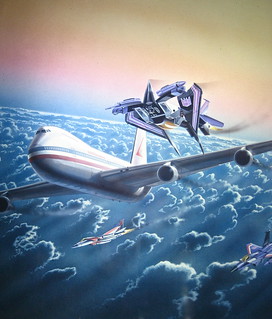 | 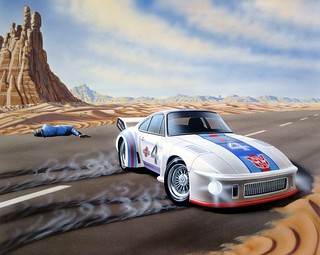 |
|---|
I did get to keep most of my artwork but not all of it. Back in those days, the client paid for first rights which meant they could use it for one use and that you got back the original artwork. Sometimes they wanted the original and payed extra for it, or they wanted all rights to it and they may want the art also. I guess I got back 80% of my artwork.
Questions about the collaborative process: You explained interactions with agents, authors, art directors and editors. Did this degree of collaboration with others only exist at the onset of a project when ideas were discussed, and then you handled all of the execution? I know in comics there are pencilers and colorists that handle different parts of an illustration, but did you find yourself doing the majority of the work on most projects during the 70s and 80s? Did you ever work as part of a team of artist illustrators?
David Schleinkofer: Interaction with art directors in the 70-80's was common. They wanted to meet you in person and discuss the project and see if you had any ideas right off the bat. Later in the late 80-and 90's it was mostly a faxed outline of the job and a phone call to discuss the job. Most everything was done by fax and FED-EX. I use to go to NY on the train in the early years and it was fun to get into the city and meet people. Later staying at home it wasn't as much fun but you did get more done by not having to travel. Sometimes an art director gave me a quick, badly drawn sketch to give me an idea about what he wanted to see in my sketch. That was mostly in advertising. Books and magazines were more up to what I could come up with. I usually did 3 different ideas or versions of one idea for them to see and they almost always found one they liked. I always did all of the art by myself at home in my studio both sketches and finishes. I never work with others as a team. Even on something like Transformers, my style was a little different from Jeff Mangiat or Mark Watts who were other artist with Mendola LTD. at the time. They were assigned the front of the boxes and I just did the large battle scene for the back of the box. Later, Jeff got to do the back of the next wave of toy boxes. I couldn't fit it in my schedule.
Questions about the Transformers: With the toy line released in 1984, I would guess you did the iconic Transformers battle scene in 1983. Do you remember the specific timeframe you were hired to do that piece? Was it Thanksgiving or Christmastime? Do you recall there being a pretty tight deadline on that one? Was that work done directly for Hasbro or was it for a company Hasbro contracted to do their illustration? Did you ever go to Hasbro's offices? Do you remember who the art director was on those Transformer projects? Do you remember doing any other Transformer illustrations outside of the battle scene and the Colorforms pieces? The insignias identifying the Autobots and Decepticons are now iconic symbols. Did you design those? Did you add those to the painting on each robot, or was this done later by Hasbro?
David Schleinkofer: I do not remember what time of the year it was when I painted the Transformer piece. I think They gave me enough time to paint it about 2-3weeks. Of course I spent another week just working on the sketches for the job. Whoever I met to go over the job with, he was in New york, and I thought it was an advertising agency who was handling the new USA packaging. I don't remember more than that. I did not design the logos for Autobots/Decepticons. If the logo appeared on the toy in the battle scene than I would have painted it in the illustration.
More questions about the battle scene: The 1984 Transformers battle scene is the Mona Lisa of a generation of toy robot loving kids. Do you remember much about the process behind creating it? You mentioned being given toys as reference material-were you given any other reference material like animation model sheets and such? Did you have lots of Transformers splayed out on a table as you worked? How many robots did they give you? Were you given the toys as reference to keep or did you have to give them back? Was there a mandate to render the robots as close to their toy likenesses as possible? Did you get to choose which toys made it into the painting or did Hasbro have certain ones in mind? Some toys appear multiple times in the battle scene-do you remember why this was done? You mentioned oftentimes doing alternate versions of a piece to show to clients-was this done for the '84 Transformers battle scene? Do you get royalties from this painting?
David Schleinkofer: I was given one of each toy that appeared in the battle scene. They also gave me some line art from Japan which showed different poses and colors for the toys. I opened up the toys into their robot forms and then I had some trouble getting them to fold back up to their original objects. I remember telling my wife that I didn't think kids would like these because they were to hard to manipulate. I think I was way off on that don't you? I didn't get to keep them as they wanted everything returned. They told me they wanted certain characters prominent and to just use the others to fill in the battle scene. Some were used more than once to fill up space. I did do 2 slightly different sketches for the battle scene. I got paid a BUY-OUT fee for the art usage-for life. They let me keep the original artwork. I won't say what I got paid. I thought it was a lot at the time but had no way of knowing it would become such a monster of a franchise. I receive no more royalties. I sold the original for cheap 20 years ago before Transformers really took off to a comic book collector.
I hope I have answered most of your questions and thanks again for taking interest in my work.
David Schleinkofer




















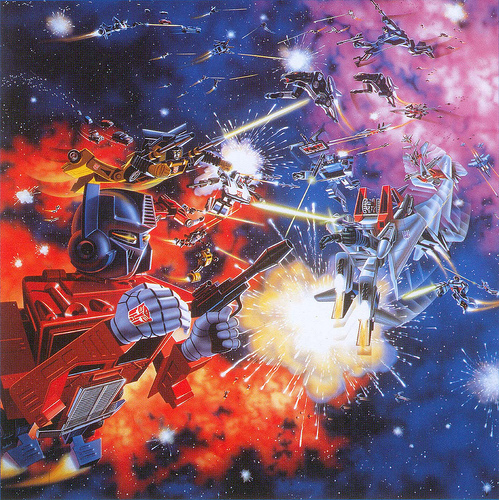


No comments:
Post a Comment